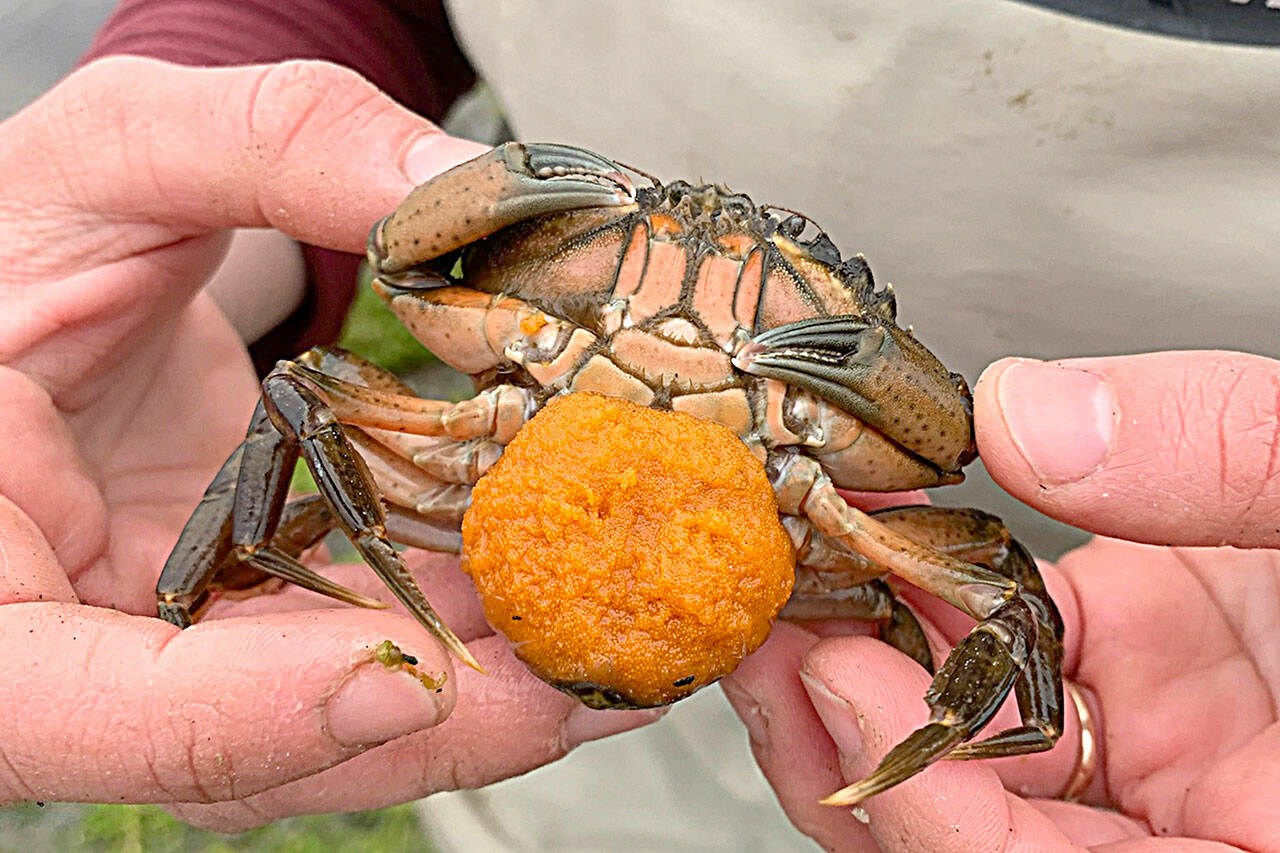Traps are filling up with European green crabs along the Olympic Peninsula’s shorelines – particularly on the peninsula’s West End.
Makah Fisheries Management staff in Neah Bay report captures for the invasive species have far surpassed anything they’ve seen since trapping began in 2017.
As of Sept. 2, staff and volunteers have captured more than 17,500 crabs since April, marine ecologist Adrianne Akmajian said.
Their previous high was 1,460 captures in 2021 between the Tsoo-Yess River, Wa’atch River and near Tsoo-Yess Beach.
“There are some alarming trends,” Akmajian said. “We’re seeing very small crabs, hundreds, now thousands of small crabs less than one inch. These are new settlers.”
Resource managers across the state say European green crabs are a threat to local eelgrass, shellfish (Dungeness crab) and estuary habitat.
Akmajian said this was the first year they’ve caught a pregnant female, and several mating pairs. Females can release up to 500,000 larvae at least once a year, which can travel as far as 100 kilometers, state officials report.
Causing further concern is that September and October were big yields for staff in 2021, and Akmajian said she’s worried staff will capture far more this season.
The green crab threat was further highlighted late last year after 70,000 green crabs were captured in the Lummi Nation’s Sea Pond west of Bellingham.
Gov. Jay Inslee issued an emergency proclamation in January for the Washington Department of Fish and Wildlife to eradicate or prevent establishment of the crab.
Fish and Wildlife staff report resource managers in 2022 statewide have removed about 138,000 green crabs (as of Aug. 7).
Blitz and research
Akmajian was able to use emergency funding to hire additional staff, including a green crab biologist and technicians, while continuing to work with volunteers.
her team has also led two “Trapping Blitzes,” with the first session Aug. 2-5 in unison with Fish and Wildlife and Washington Sea Grant staff, that placed 780 traps and captured more than 5,300 crabs.
The second blitz Aug. 15-19 saw Makah staff set 160 traps and capture 3,600 green crabs.
“Almost anywhere you put a trap, you’re going to trap crabs,” Akmajian said. “We’re pulling hairs here.”
Neah Bay locals are aware of the threat, she said, and residents and fishermen are reaching out when they spot green crab. Makah Fisheries Management and the Makah Tribe have also put out more signage and articles in the local newsletter.
Makah staff also did two weeks of marking and recapturing green crab in July to track migration and population growth. For all 17,000-plus green crabs, staff have taken pertinent data such as size, sex, condition, color and other characteristics.
Looking ahead, Akmajian anticipates heavy trapping through October — and possibly over the winter months, depending on weather and water levels.
Staff will use a new research vessel to try trapping in deeper waters; Akmajian said some Canadian resource managers are capturing crabs at 60-100 feet.
They’ll also look to hire more local staff, and take time to analyze underwater video observing crabs’ interactions, she said
“I feel positive about the amount of effort we’ve had,” Akmajian said. “The additional funding has been important to do this much effort. It appears the population is exploding.
“Our obvious goal is to control the population to manageable levels. I’m not sure what that is right now … but I’d like to keep up the heavy effort and see numbers decline.”
Sequim and Dungeness
Totals in the Sequim area haven’t ballooned like Neah Bay, but resource managers here have continued to find signs of the invasive species.
In Sequim Bay, Neil Harrington, an environmental biologist for the Jamestown S’Klallam Tribe, has caught two green crabs from 710 traps. That’s down from 16 caught from 760 traps in 2021, he reports.
Tribal staff first caught a green crab in 2017 in Sequim Bay, and two more in 2019.
Harrington said he’s looking to stop trapping for the year in October. For the season, Fish and Wildlife provided the tribe equipment and helped trap in “priority areas,” he said, and they received Environmental Protection Agency funds for staffing and equipment.
On the Dungeness Spit, Washington Maritime National Wildlife Refuge’s staff and volunteers have been trapping for early detection for years and first caught a green crab in 2017.
Lorenz Sollmann, the Washington Maritime National Wildlife Refuge’s deputy project leader, said volunteers have caught 15 green crabs (10 males and five females) from 764 traps since April, along with one molt.
Fourteen were caught in the Graveyard Spit channel and one was in the Base Lagoon, he said.
Last year, refuge volunteers caught eight crabs fro 839 traps, and three crabs from 1,883 traps in 2020.
With two more weeks of trapping planned in September, Sollmann said “the refuge has been relying heavily on our wonderful refuge volunteers who have been trained by Sea Grant’s Crab Team.”
The refuge has not received any emergency funding for trapping this year, he said.
In Jefferson County, Fish and Wildlife staff caught two green crabs at Bishop’s Point on Indian Island Naval Base in May 2021, but no further captures have been reported.
Identification
Fish and Wildlife staff said they continue to receive reports of misidentified European green crab, a shore crab found in shallow areas with five spines on the side of each eye, and they may be green, yellow, orange or red.
Fish and Wildlife staff request the public to only photograph and report suspected green crab at wdfw.wa.gov/greencrab. They’ll follow up with trapping and monitoring if needed, they said.



